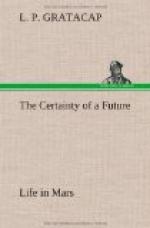At first he only dimly intimated his great ambition, the union of our world with others by magnetic waves, but as it slowly assumed a theoretical certainty he talked more and more boldly of this portentous and transforming possibility.
I cannot refrain from noticing another important scientific activity of my father’s. It was the use of photography in stellar measurement. As is well known to photographers, in 1871 Dr. R.L. Maddox used gelatine in place of collodion from which innovation rose the present system of dry plate photography. My father had always felt the greatest interest in the use of photography in astronomy. He was acquainted with the splendid work done by Chapman for Rutherford, New York, in his careful and exquisite photographs of the moon. As early as 1850 Whipple of Boston made photographs of the stars.
It was, however, the incomparable advantages, furnished in speed, by the dry plate photography which made my father realize early as anyone, the boundless possibilities thus opened in human attainment for the penetration of the Sidereal firmament. He had made a great number of photographs at Irvington, and the photographic laboratory was a charming illustration of my father’s ingenuity and precision. At Mt. Cook we enjoyed a marvellously clear atmosphere for work of this sort, and amongst the first thoughts of my father was to provide the most satisfactory means for the continuance of our stellar photography. Besides our visual telescope we had a photographic telescope which was used, instead of connecting the visual lens on one and the same instrument, as in the Lick Observatory.
The innovations introduced by photography have revolutionized the processes of stellar measurement. Instead of the laborious task of measuring the stars through the telescope, the photographic plate can be studied at ease as a correct and identical chart of the heavens and the results thus obtained placed at the disposal of astronomers. My father appreciated this and amongst his numerous projects of scientific usefulness the preparation of photographs of the stars fully occupied his mind.
We had no Meridian Circle, as it was less in the direction of the determination of the position of stars than in the elucidation of the surfaces of planets, that my father’s astronomical predilections lay. Our telescope was a refractor and had an objective of two feet diameter. It was firmly supported on a trap rock pedestal. The eye piece adjustment was unusually successful, and the remarkable freedom of the objective from any traces of spherical or chromatic aberration gave us an image of surprising clearness. The photographic results were admirable. I imagine few more satisfactory photographs of the face of Moon have been made than those we secured, so far at least as definition is concerned, and the detail within the limits of our powers of magnification.
The telescope was very slowly installed and it was well in 1885 before we were able to use it for either observation or photography.




